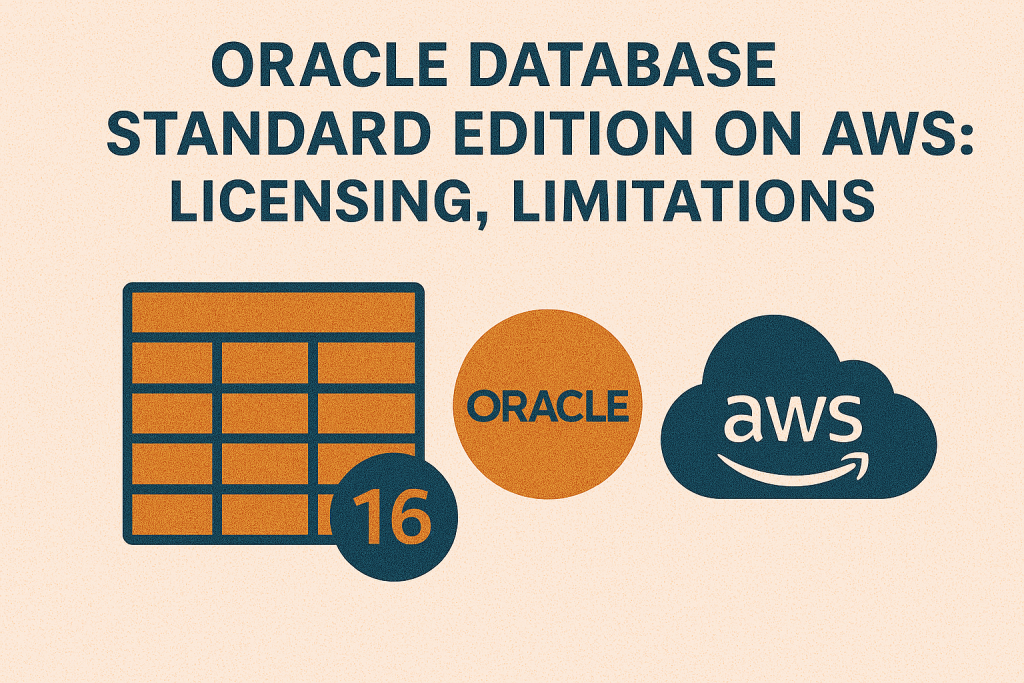
Oracle Database Standard Edition on AWS: Licensing, Limitations, and Best Practices
Oracle Database Standard Edition (SE2) is fully supported on AWS, but you need to understand the clear licensing and technical constraints. This article clearly explains how SE2 licensing works on AWS, outlines critical limitations, and provides practical examples to help you remain compliant and cost-effective.
Read Oracle on AWS Licensing FAQs 1 of 4
Can I Run Oracle Standard Edition (SE2) on AWS?
Yes, Oracle SE2 can be deployed on AWS, but several key limitations apply:
- Instance Size Limit
- License Counting Rules
- No RAC Support
- Limited Feature Set
Understanding these constraints clearly will ensure your SE2 deployment on AWS is both compliant and effective.
Key Limitation #1: Instance Size Limit for SE2 on AWS
Oracle explicitly limits Standard Edition 2 (SE2) to a maximum of 8 vCPUs per instance in authorized cloud environments (such as AWS).
Clearly Explained Limit:
- Oracle’s SE2 limitation is aligned with its on-premises policy (max 2 sockets × 4 cores each = 8 cores total).
- The SE2 vCPU limit is strictly enforced on AWS as 8 vCPUs per instance (equivalent to ~8 cores).
Practical Example:
- Acceptable AWS instance types for SE2:
m5.2xlarge(8 vCPUs)r5.2xlarge(8 vCPUs)
- Instance types exceeding eight vCPUs (e.g.,
m5.4xlargewith 16 vCPUs) are not compliant with SE2.
Clearly Explained Impact:
- If your database workload requires more than eight vCPUs, Oracle SE2 is unsuitable. You must:
- Deploy multiple separate SE2 databases (horizontal scaling), or
- Upgrade to Oracle Enterprise Edition (no vCPU limit, but higher cost).
Read Oracle’s Processor Core Factor Table and AWS Licensing..
Key Limitation #2: Counting Oracle SE2 Licenses on AWS
The on-premises count of Oracle SE2 licenses, but Oracle uses simplified rules for AWS based on vCPUs.
Clearly Explained License Counting on AWS:
- Oracle clearly defines SE2 licenses on AWS as:
- 1 SE2 license per 4 vCPUs (or fraction thereof)
Practical Example:
| AWS Instance Type (SE2) | vCPUs | Required SE2 Licenses (Clearly Explained) |
|---|---|---|
t3.xlarge | 4 vCPUs | Requires 2 SE2 licenses |
m5.2xlarge | 8 vCPUs | Clearly requires 2 SE2 licenses |
- There are clearly no fractional licenses; if instance vCPUs exceed 4, you must round up to the next SE2 license.
Clearly Explained Cost Benefit:
- SE2 licenses are significantly cheaper than EE licenses.
- SE2 offers cost-effective licensing for smaller AWS deployments.
Key Limitation #3: No Oracle RAC Support for SE2 on AWS
Oracle Real Application Clusters (RAC) are not supported with Oracle SE2 on AWS:
- Oracle SE2 has explicitly forbidden RAC usage (since 2015).
- AWS also clearly does not support RAC natively for SE2.
Practical Example Clearly Explained:
- AWS deployment of SE2 clearly cannot use a multi-node RAC configuration.
- We must use AWS-native HA (high availability) features instead:
- AWS Multi-AZ deployments (via RDS)
- EC2-based HA setups (e.g., failover scripts, standby EC2 instances, etc.)
Clearly Explained Impact:
- For high availability with SE2, rely on AWS solutions instead of Oracle RAC.
Key Limitation #4: Oracle SE2 Feature Set Clearly Explained
Oracle SE2 has fewer features compared to Enterprise Edition:
Features NOT available in SE2:
- Oracle Partitioning
- Advanced Compression
- Parallel Query
- Data Guard Broker (automated failover management)
- Advanced Security Options (TDE)
Clearly Explained Impact:
- If these features are critical, SE2 clearly will not meet your requirements. Consider Enterprise Edition instead.
SE2 Advantage Clearly Explained:
- Licensing simplicity avoids accidentally using unlicensed features (these EE-only features aren’t available in SE2).
Common Oracle SE2 Use Cases on AWS Clearly Explained
Oracle SE2 is ideal for:
- Small to medium databases where eight vCPUs provide sufficient processing.
- Departmental applications, legacy workloads, and modest growth scenarios benefit from SE2’s lower licensing costs.
Practical Examples:
- Suitable AWS SE2 deployment examples:
- Departmental HR database supporting ~100 concurrent users.
- A small web application database requires moderate performance.
- Unsuitable AWS SE2 deployment examples:
- Large data warehouse requiring partitioning or parallel queries.
- Critical financial application needing RAC or EE-only advanced security features.
Oracle SE2 Licensing Compliance Checklist for AWS
Use this checklist for Oracle SE2 on AWS:
✅ Ensure the AWS instance size does not exceed eight vCPUs for SE2.
✅ Count licenses as 1 SE2 license per 4 vCPUs (rounding up).
✅ Rely on AWS-native HA solutions (not RAC).
✅ Verify SE2’s feature set matches your workload requirements.
✅ Document instance types, license counts, and feature usage for compliance.
Common Oracle SE2 Licensing Misunderstandings Corrected Clearly
- Misconception: “Oracle SE2 licensing on AWS matches Enterprise Edition rules.”
- Reality: Different licensing model (vCPU limits, no RAC, fewer features).
- Misconception: “You can license more than eight vCPUs with Oracle SE2.”
- Reality: Limited to a maximum of 8 vCPUs per AWS instance.
- Misconception: “Oracle RAC can be used for high availability with SE2 on AWS.”
- Reality: It is not supported. We must use AWS HA solutions instead.
Practical Summary: Oracle SE2 Licensing and Limitations on AWS
| SE2 Limitation on AWS | Licensing Rule Clearly Explained | Practical Impact |
|---|---|---|
| Instance Size Limit | Not supported with SE2 on AWS | No vertical scaling beyond 8 vCPUs |
| License Counting | Max 8 vCPUs per instance | Cost-effective licensing for small DBs |
| RAC Support | Use AWS-native HA solutions | Ensure feature needs match SE2 capabilities |
| Feature Set | No vertical scaling beyond eight vCPUs | Fewer features than EE |
Conclusion: Clearly Understanding Oracle SE2 on AWS
Running Oracle SE2 on AWS is supported but subject to important technical and licensing limitations. Clearly understanding these restrictions—maximum 8 vCPUs per instance, simpler licensing (1 license per 4 vCPUs), lack of RAC support, and limited feature availability—ensures your AWS deployment remains compliant and cost-effective.
Choosing Oracle SE2 on AWS can offer significant cost savings, provided your workload fits these constraints.
